Analysis of Flaw Detection Sensitivity of Phased Array Ultrasonics in Austenitic Steel Welds According to Inspection Conditions
Abstract
1. Introduction
2. Austenitic Steel Weld and PA Probe Modeling
2.1. Austenitic Steel Weld Modeling
2.2. Probe Modeling
3. Analysis of Propagation Behavior of PA Ultrasonic Beams
3.1. Beam Computation Simulation
3.2. Beam Path Ray and Scan Plan
4. Flaw Detection Sensitivity Analysis
4.1. Sensitivity Calibration
4.2. Flaw Detection
4.3. Simulation Results
4.3.1. S-Wave Sectorial Scan
4.3.2. L-Wave Sectorial Scan
5. Experimental Setup
6. Conclusions
Author Contributions
Funding
Institutional Review Board Statement
Informed Consent Statement
Data Availability Statement
Conflicts of Interest
References
- Shafeek, H.; Gadelmawla, E.; Abdel-Shafy, A.; Elewa, I. Assessment of welding defects for gas pipeline radiographs using computer vision. NDT E Int. 2004, 37, 291–299. [Google Scholar] [CrossRef]
- De Carvalho, A.A.; Rebello, J.; Souza, M.; Sagrilo, L.; Soares, S. Reliability of non-destructive test techniques in the inspection of pipelines used in the oil industry. Int. J. Press. Vessel. Pip. 2008, 85, 745–751. [Google Scholar] [CrossRef]
- Olympus. Phased Array Testing: Basic Theory for Industrial Applications. Available online: https://www.olympus-ims.com.cn/en/books/pa/pa-testing/ (accessed on 30 December 2020).
- Song, S.-J.; Shin, H.J.; Jang, Y.H. Development of an ultrasonic phased array system for nondestructive tests of nuclear power plant components. Nucl. Eng. Des. 2002, 214, 151–161. [Google Scholar] [CrossRef]
- von Ramm, O.T.; Smith, S.W. Beam steering with linear arrays. IEEE Trans. Biomed. Eng. 1983, 8, 438–452. [Google Scholar] [CrossRef]
- Feng, Q.; Li, R.; Nie, B.; Liu, S.; Zhao, L.; Zhang, H. Literature Review: Theory and Application of In-Line Inspection Technologies for Oil and Gas Pipeline Girth Weld Defection. Sensors 2016, 17, 50. [Google Scholar] [CrossRef]
- Hirasawa, T.; Fukutomi, H.; Ishii, A. Basic study on the phased array UT technique for crack depth sizing in Ni-based alloy weld. E J. Adv. Maint. 2013, 5, 146–154. [Google Scholar]
- Satyarnarayan, L.; Pukazhendhi, D.M.; Balasubramaniam, K.; Krishnamurthy, C.V.; Murthy, D.S.R. Phased Array Ultrasonic Measurement of Fatigue Crack Growth Profiles in Stainless Steel Pipes. J. Press. Vessel. Technol. 2006, 129, 737–743. [Google Scholar] [CrossRef]
- Kawanami, S.; Kurokawa, M.; Taniguchi, M.; Tada, Y. Development of phased-array ultrasonic testing probe. Mitsubishi Juko Giho 2001, 38, 154–157. [Google Scholar]
- Bredif, P.; Plu, J.; Pouligny, P.; Poidevin, C. Phased-Array Method for the Ut-Inspection of French Rail Repairs. AIP Conf. Proc. Am. Inst. Phys. 2008, 975, 762–769. [Google Scholar]
- Hansen, W.; Hintze, H. Ultrasonic testing of railway axles with the phased array technique–experience during operation. Insight-Non-Destr. Test. Cond. Monit. 2005, 47, 358–360. [Google Scholar] [CrossRef]
- Kappes, W.; Rockstroh, B.; Bahr, W.; Kroning, M.; Rodner, C.; Goetz, J.; Nemec, D. Application of new front-end electronics for non-destructive testing of railroad wheel sets. Insight-Northamp. Incl. Eur. Issues 2007, 49, 345–349. [Google Scholar] [CrossRef]
- Mohammadkhani, R.; Fragonara, L.Z.; Padiyar, M.J.; Petrunin, I.; Raposo, J.; Tsourdos, A.; Gray, I. Improving Depth Resolution of Ultrasonic Phased Array Imaging to Inspect Aerospace Composite Structures. Sensors 2020, 20, 559. [Google Scholar] [CrossRef]
- Heida, J.H.; Platenkamp, D.J. In-service inspection guidelines for composite aerospace structures. In Proceedings of the 18th World Conference on Nondestructive Testing, Durban, South Africa, 16–20 April 2012; pp. 16–20. [Google Scholar]
- Engl, G.; Meier, R.; Brandt, C. Testing large aerospace CFRP components by ultrasonic multichannel conventional and phased array pulse-echo techniques. Insight Non-Destructive Test. Cond. Monit. 2003, 45, 202–205. [Google Scholar] [CrossRef]
- Wilkinson, S.; Duke, S.M. Comparative Testing of Radiographic Testing, Ultrasonic Testing and Phased Array Advanced Ultrasonic Testing Nondestructive Testing Techniques in Accordance with the AWS D1. 5 Bridge Welding Code. Available online: https://trid.trb.org/view/1307243 (accessed on 30 December 2020).
- Schroeder, C.J. Inspection of Steel Bridge Welds Using Phased Array Ultrasonic Testing. Ph.D. Thesis, Purdue University, West Lafayette, IN, USA, 2019. [Google Scholar]
- Badji, R.; Bacroix, B.; Bouabdallah, M. Texture, microstructure and anisotropic properties in annealed 2205 duplex stainless steel welds. Mater. Charact. 2011, 62, 833–843. [Google Scholar] [CrossRef]
- Chen, X.; Lu, J.; Lu, L.; Lu, K. Tensile properties of a nanocrystalline 316L austenitic stainless steel. Scr. Mater. 2005, 52, 1039–1044. [Google Scholar] [CrossRef]
- Belyakov, A.; Miura, H.; Sakai, T. Dynamic recrystallization under warm deformation of a 304 type austenitic stainless steel. Mater. Sci. Eng. A 1998, 255, 139–147. [Google Scholar] [CrossRef]
- Yu, H.; Yang, J.; Yin, J.; Wang, Z.; Zeng, X. Comparison on mechanical anisotropies of selective laser melted Ti-6Al-4V alloy and 304 stainless steel. Mater. Sci. Eng. A 2017, 695, 92–100. [Google Scholar] [CrossRef]
- Azar, L.; Shi, Y.; Wooh, S.-C. Beam focusing behavior of linear phased arrays. NDT E Int. 2000, 33, 189–198. [Google Scholar] [CrossRef]
- Lee, J.-H.; Choi, S.-W. A parametric study of ultrasonic beam profiles for a linear phased array transducer. IEEE Trans. Ultrason. Ferroelectr. Freq. Control. 2000, 47, 644–650. [Google Scholar] [CrossRef]
- Peng, Y.U.; Gang, T. The Use of Multi-Mode TFM to Measure the Depth of Small Surface-Break Cracks in Welds. In Proceedings of the 2017 Far East NDT New Technology & Application Forum (FENDT), Xi’an, China, 22–24 June 2017; pp. 106–110. [Google Scholar]
- Sy, K.; Bredif, P.; Iakovleva, E.; Roy, O.; Lesselier, D. Development of methods for the analysis of multi-mode TFM images. J. Phys. Conf. Ser. 2018, 1017, 012005. [Google Scholar] [CrossRef]
- Hunter, A.; Drinkwater, B.W.; Wilcox, P.D. The wavenumber algorithm for full-matrix imaging using an ultrasonic array. IEEE Trans. Ultrason. Ferroelectr. Freq. Control. 2008, 55, 2450–2462. [Google Scholar] [CrossRef] [PubMed]
- Moysan, J.; Apfel, A.; Corneloup, G.; Chassignole, B. Modelling the grain orientation of austenitic stainless steel multipass welds to improve ultrasonic assessment of structural integrity. Int. J. Press. Vessel. Pip. 2003, 80, 77–85. [Google Scholar] [CrossRef]
- Gueudré, C.; Mailhe, J.; Ploix, M.-A.; Corneloup, G.; Chassignole, B. Influence of the uncertainty of elastic constants on the modelling of ultrasound propagation through multi-pass austenitic welds. Impact on non-destructive testing. Int. J. Press. Vessel. Pip. 2019, 171, 125–136. [Google Scholar] [CrossRef]
- Kolkoori, S. Quantitative Evaluation of Ultrasonic Wave Propagation in Inhomogeneous Anisotropic Austenitic Welds Using 3D ray Tracing Method: Numerical and Experimental Validation. Ph.D. Thesis, Technische Universität, Berlin, Germany, 2014. [Google Scholar]
- Aizpurua, I.; Ayesta, I.; Castro, I. Characterization of anisotropic weld structure for nuclear industry. In Proceedings of the 11th European Conference on Non-Destructive Testing (ECNDT 2014), Prague, Czech Republican, 6–10 October 2014. [Google Scholar]
- Nageswaran, C.; Carpentier, C.; Tse, Y.Y. Microstructural quantification, modelling and array ultrasonics to improve the inspection of austenitic welds. Insight Non-Destructive Test. Cond. Monit. 2009, 51, 660–666. [Google Scholar] [CrossRef][Green Version]
- Langenberg, K.; Hannemann, R.; Kaczorowski, T.; Marklein, R.; Koehler, B.; Schurig, C.; Walte, F. Application of modeling techniques for ultrasonic austenitic weld inspection. NDT E Int. 2000, 33, 465–480. [Google Scholar] [CrossRef]
- Harrigan, T.P.; Mann, R.W. Characterization of microstructural anisotropy in orthotropic materials using a second rank tensor. J. Mater. Sci. 1984, 19, 761–767. [Google Scholar] [CrossRef]
- Chassignole, B.; EI Guerjouma, R.; Ploix, M.A.; Fouquet, T. Ultrasonic and structural characterization of anisotropic austenitic stainless steel welds: Towards a higher reliability in ultrasonic non-destructive testing. NDT E Int. 2010, 43, 273–282. [Google Scholar] [CrossRef]
- Carter, B.J.; Wawrzynek, P.A.; Ingraffea, A.R. Automated 3-D crack growth simulation. Int. J. Numer. Methods Eng. 2000, 47, 229–253. [Google Scholar] [CrossRef]
- Cortés, R.; Rodríguez, N.K.; Ambriz, R.R.; López, V.H.; Ruiz, A.; Jaramillo, D. Fatigue and crack growth behavior of Inconel 718–AL6XN dissimilar welds. Mater. Sci. Eng. 2019, 745, 20–30. [Google Scholar] [CrossRef]
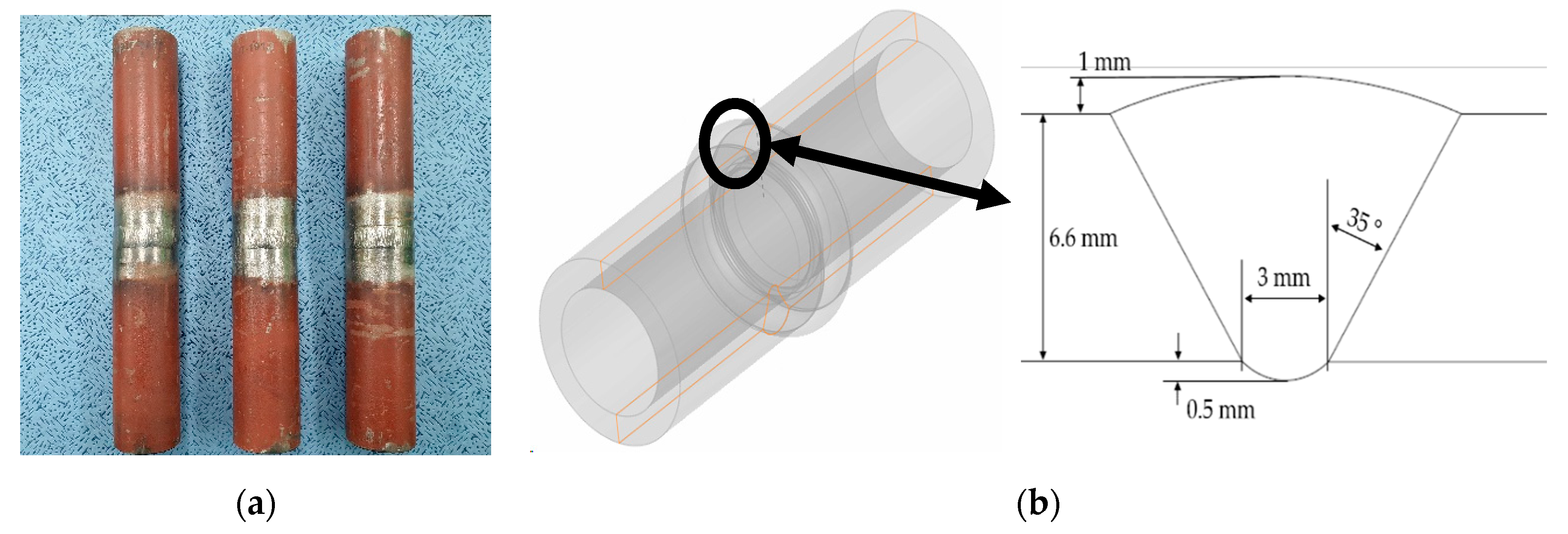
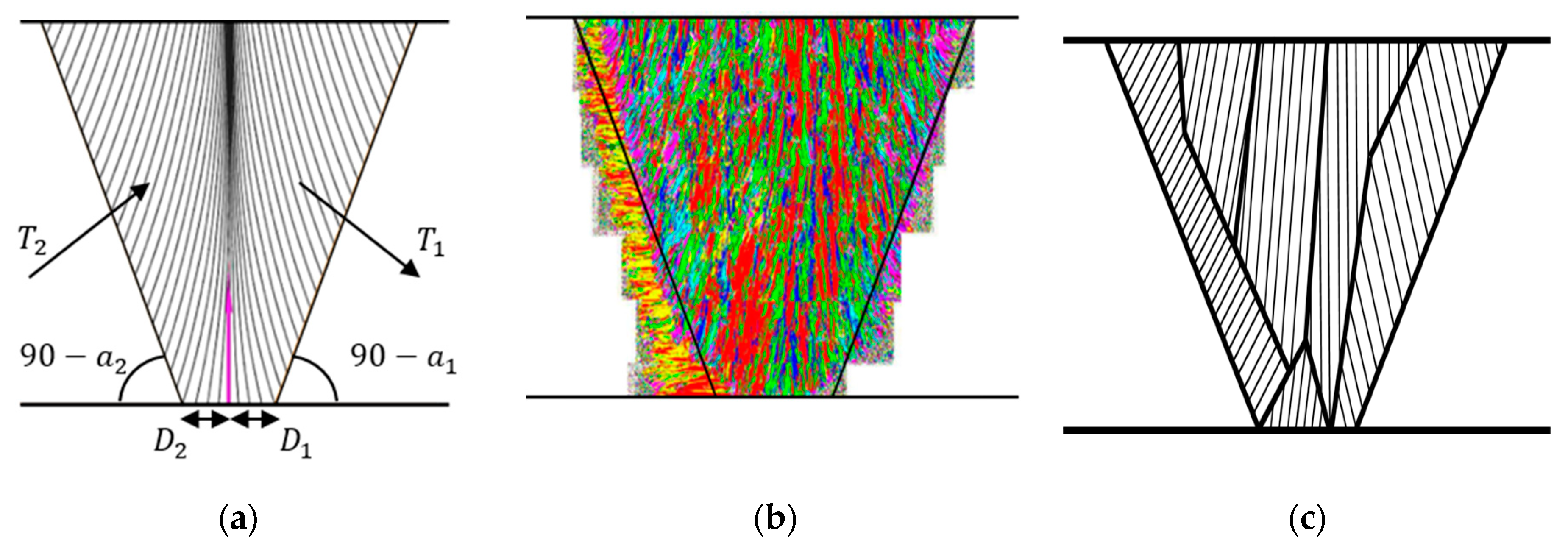




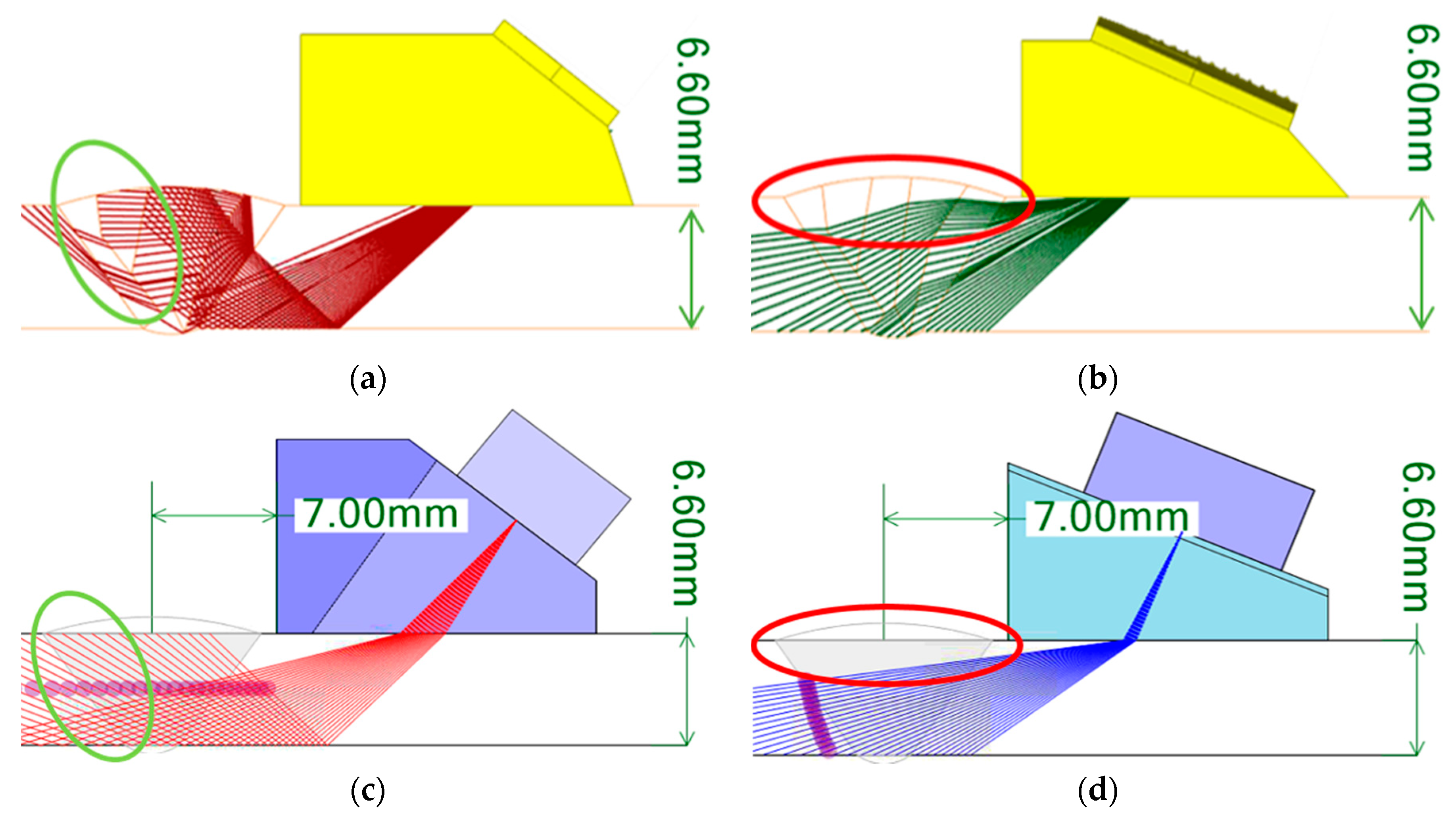

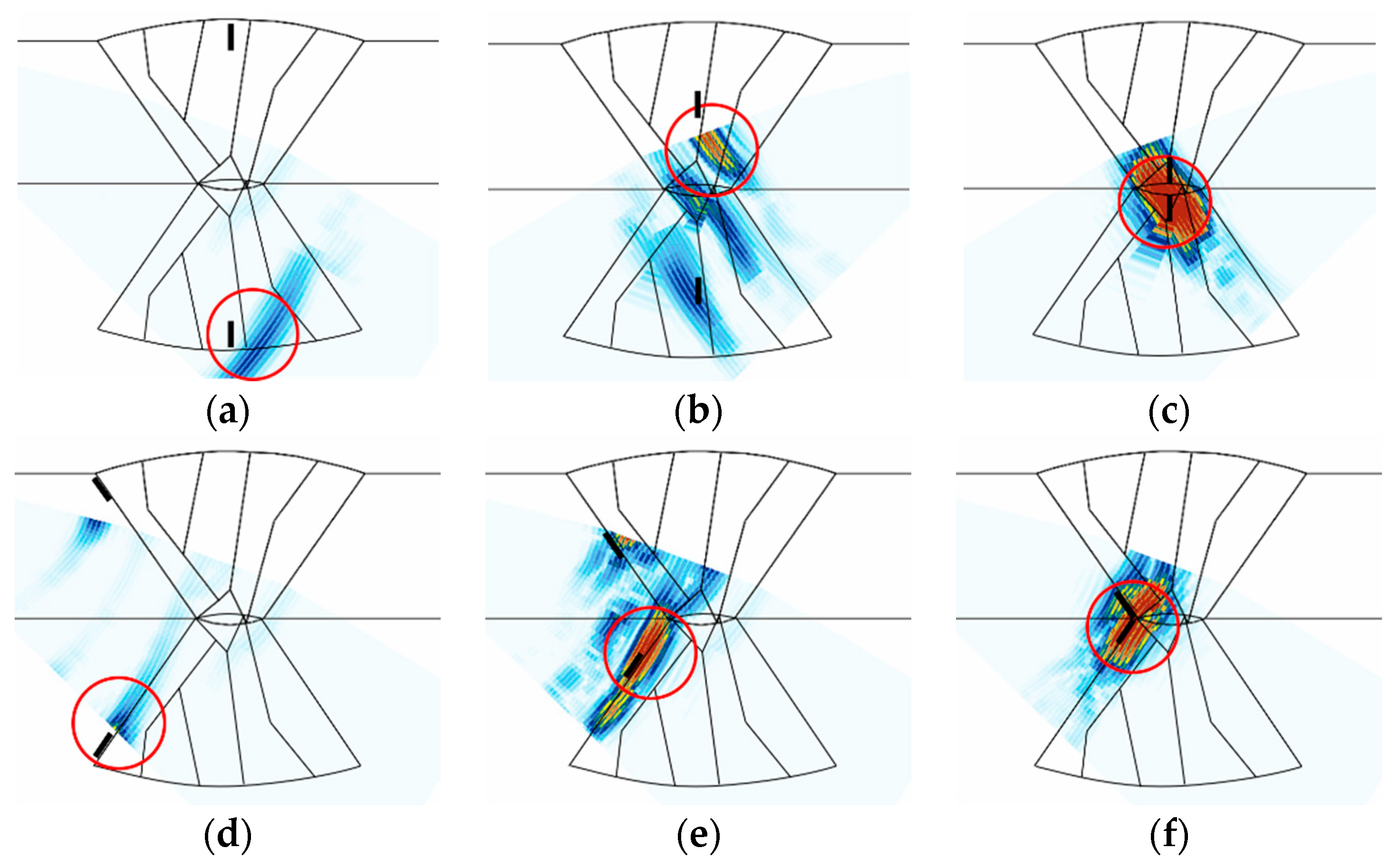
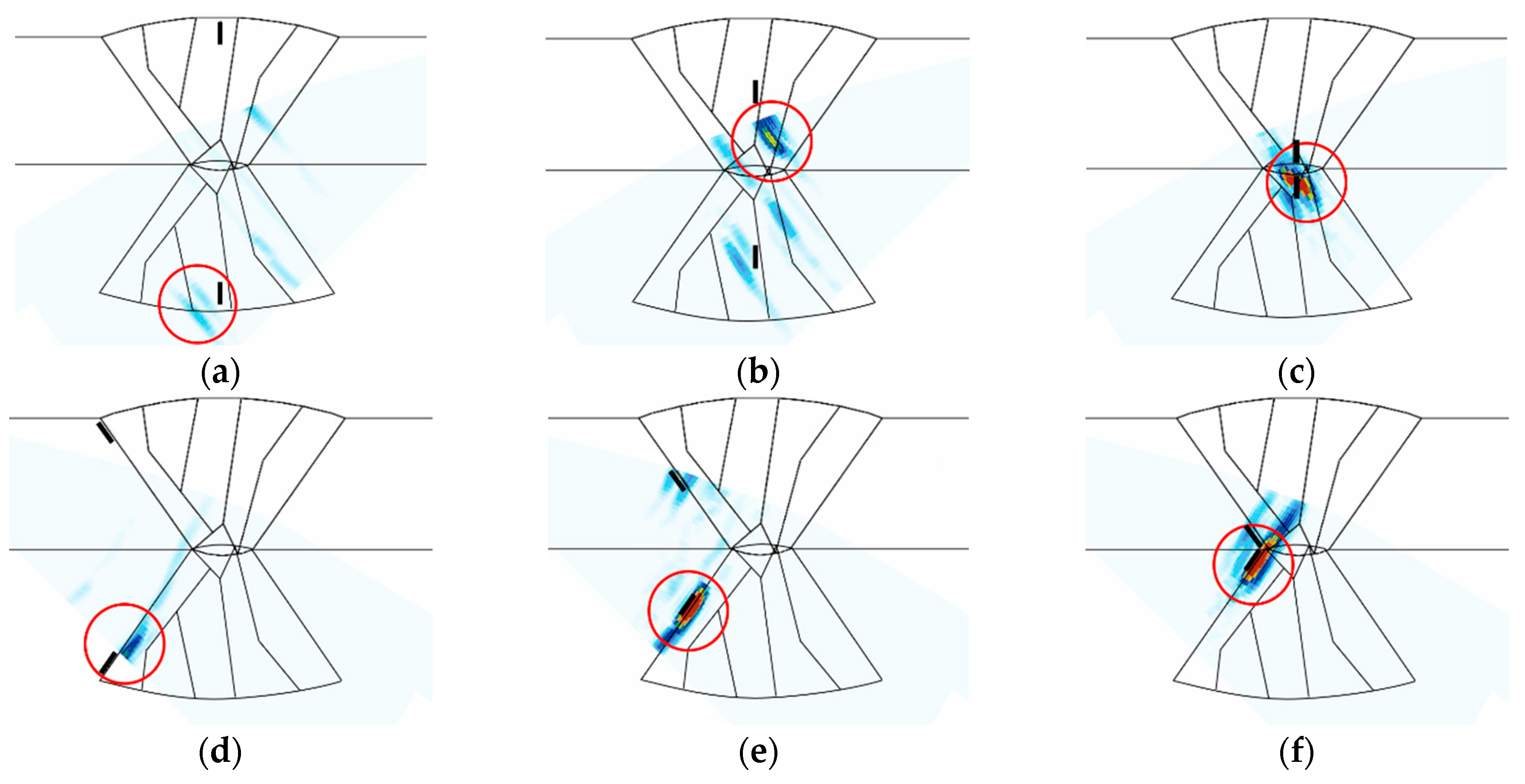
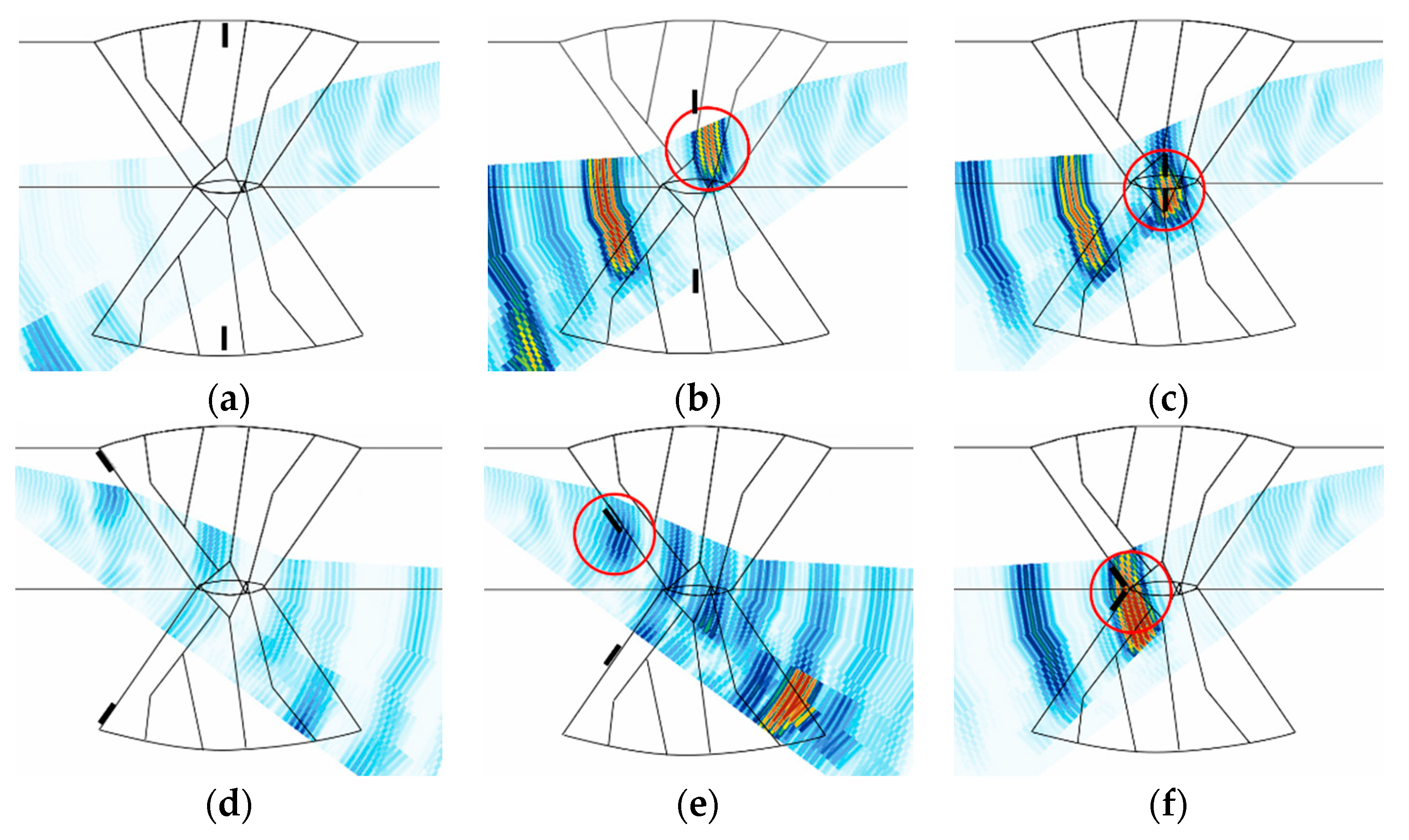
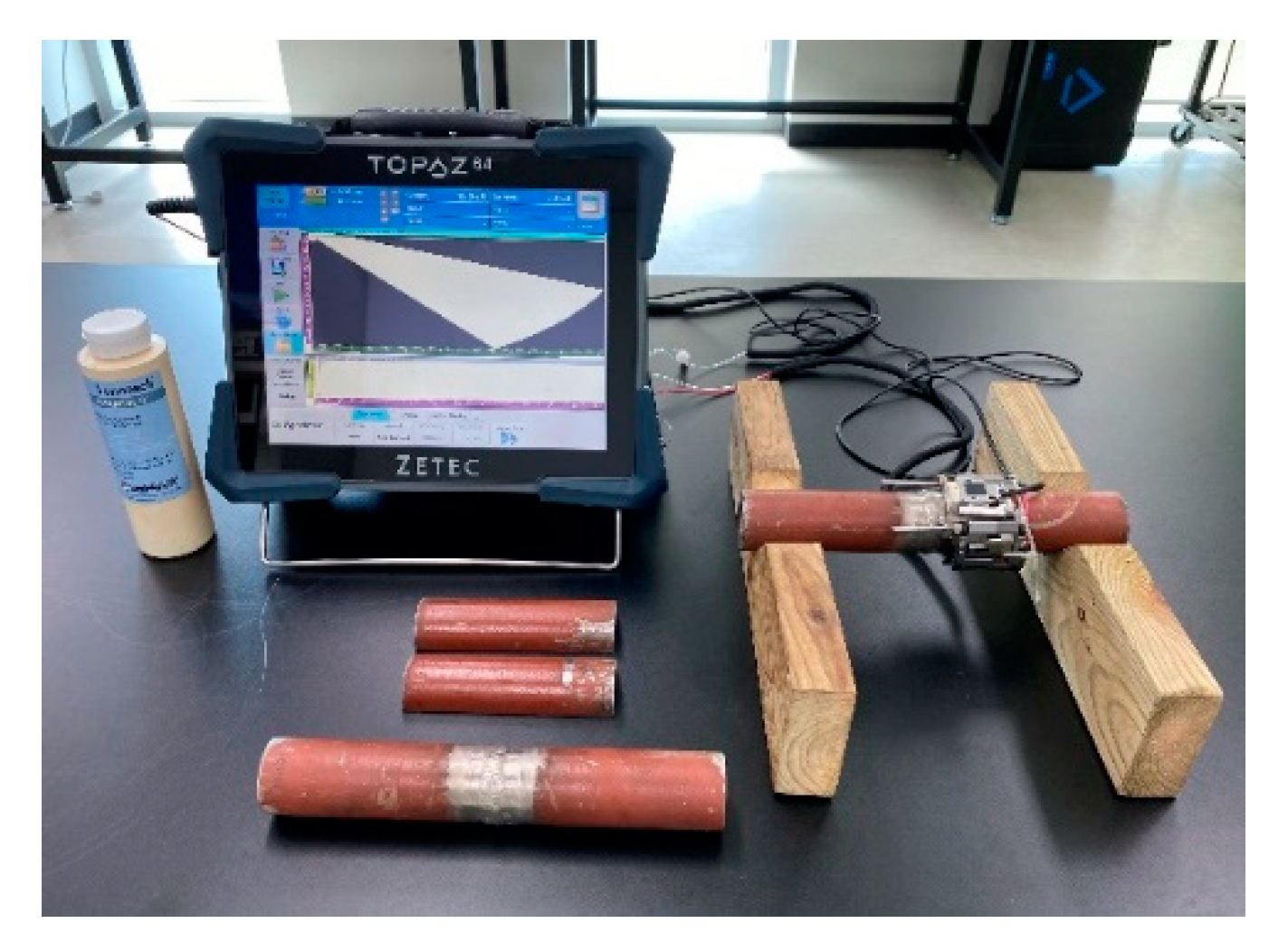




| Anisotropic Model | Ogilvy | 3 Domains | 6 Domains | 12 Domains | 24 Domains |
|---|---|---|---|---|---|
| Total time | 30 min | 30 min | 50 min | 180 min | 300 min |
| Wave Type | Longitudinal | Transverse | |
|---|---|---|---|
| Center Frequency | 5 MHz | 4 MHz | 7.5 MHz |
| Number of Elements | 162 (TR) | 16 | |
| Element Pitch | 0.75 mm | 0.5 mm | |
| Total Aperture | 12 mm | 8 mm | |
| Elevation | 5 mm | 10 mm | |
| Shape | Rectangular | ||
|---|---|---|---|
| Length | 6 mm | ||
| Height | 1 mm | ||
| Depth | 0 mm | 3 mm | 6 mm |
| Crack |  |  |  |
| Lack of Fusion (LF) |  |  |  |
| Flaw Type | Frequency (MHz) | Amplitude (%) | |
|---|---|---|---|
| Skew 90 | Skew 270 | ||
| Top Crack | 4 | 27.78 | 23.37 |
| 7.5 | 7.16 | 8.46 | |
| Middle Crack | 4 | 70.76 | 100.34 |
| 7.5 | 35.56 | 62.38 | |
| Bottom Crack | 4 | 214.67 | 374.52 |
| 7.5 | 100.88 | 229.68 | |
| Top LF | 4 | 59.51 | 27.86 |
| 7.5 | 47.1 | Not Detected | |
| Middle LF | 4 | 198.19 | 96.08 |
| 7.5 | 225.4 | 33.06 | |
| Bottom LF | 4 | 219.36 | 191.27 |
| 7.5 | 236.42 | 40.64 | |
| Flaw Type | Frequency (MHz) | Amplitude (%) | |
|---|---|---|---|
| Skew 90 | Skew 270 | ||
| Top Crack | 5 | Not detected | Not detected |
| Middle Crack | 62.86 | 101.1 | |
| Bottom Crack | 95.43 | 109.16 | |
| Top LF | Not detected | Not detected | |
| Middle LF | 33.75 | 26.23 | |
| Bottom LF | 98.85 | 193.98 | |
| Flaw Type | Frequency (MHz) | Detection | |
|---|---|---|---|
| Simulation | Experiment | ||
| Top Crack | 4 |  |  |
| 7.5 |  |  | |
| 5 |  |  | |
| Top LF | 4 |  |  |
| 7.5 |  |  | |
| 5 |  |  | |
| Others | 4 |  |  |
| 7.5 |  |  | |
| 5 |  |  | |
Publisher’s Note: MDPI stays neutral with regard to jurisdictional claims in published maps and institutional affiliations. |
© 2021 by the authors. Licensee MDPI, Basel, Switzerland. This article is an open access article distributed under the terms and conditions of the Creative Commons Attribution (CC BY) license (http://creativecommons.org/licenses/by/4.0/).
Share and Cite
Kim, Y.; Cho, S.; Park, I.K. Analysis of Flaw Detection Sensitivity of Phased Array Ultrasonics in Austenitic Steel Welds According to Inspection Conditions. Sensors 2021, 21, 242. https://doi.org/10.3390/s21010242
Kim Y, Cho S, Park IK. Analysis of Flaw Detection Sensitivity of Phased Array Ultrasonics in Austenitic Steel Welds According to Inspection Conditions. Sensors. 2021; 21(1):242. https://doi.org/10.3390/s21010242
Chicago/Turabian StyleKim, YoungLae, Sungjong Cho, and Ik Keun Park. 2021. "Analysis of Flaw Detection Sensitivity of Phased Array Ultrasonics in Austenitic Steel Welds According to Inspection Conditions" Sensors 21, no. 1: 242. https://doi.org/10.3390/s21010242
APA StyleKim, Y., Cho, S., & Park, I. K. (2021). Analysis of Flaw Detection Sensitivity of Phased Array Ultrasonics in Austenitic Steel Welds According to Inspection Conditions. Sensors, 21(1), 242. https://doi.org/10.3390/s21010242








